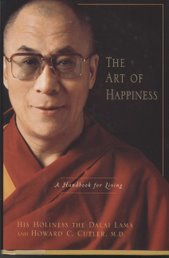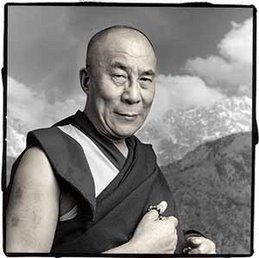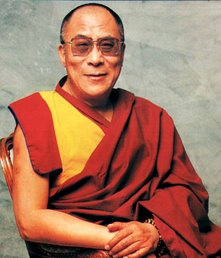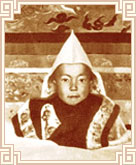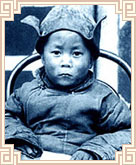
The Fifth Dalai Lama, Ngawang Lobsang Gyatso, was born in 1617 in Lhoka Chingwar Taktse, south of Lhasa to Dudul Rabten and Kunga Lhanzi.
When Sonam Choephel, the chief attendant of the Fourth Dalai Lama heard of the exceptional abilities of the Chong-Gya boy, he paid a visit to the child and showed him articles belonging to the previous Dalai Lama. The boy at once said those belonged to him. Sonam Choephel kept the discovery of the Fifth Dalai Lama a secret because of the turbulent political situation. When things settled down, the Fifth Dalai Lama was taken to Drepung monastery where he was ordained into monkhood by the Third Panchen Lama, Lobsang Chogyal, and was given the name Ngawang Lobsang Gyatso.
The Fifth Dalai Lama was recognized at a time when Tibet was in political turmoil. However, all this uncertainty was laid to rest by Gushir Khan, the chief of the Qoshot Mongols and in 1642, the Dalai Lama was enthroned in the main hall of Shigatse as both the spiritual and political leader of Tibet. In 1645, the Dalai Lama held a meeting with high officials of Gaden Phodrang on the construction of the Potala Palace on the Red Hill, where the 33rd King of Tibet Songtsen Gampo had built a red fort. In the same year, the construction started and it took almost forty-three years to complete.
In 1649, Sunzhi, the Manchu emperor, invited the Dalai Lama to Peking. When he reached the Chinese province of Ningxia, he was greeted by the emperor’s minister and military commander who came with three thousand cavalry to escort the Tibetan leader. The emperor himself traveled from Peking and greeted him at a place called Kothor. In the Chinese capital, the Dalai Lama stayed at the Yellow Palace, built for him by the emperor. When the emperor officially met the Dalai Lama, the two of then exchanged titles. In 1653, the Dalai Lama returned to Tibet.
Gushir Khan died in 1655, as did Sonam Choephel, the “Desi”. The Dalai Lama appointed Gushir Khan’s son Tenzin Dorjee as the new Mongol king, and Drong Mey-Pa Thinley Gyatso succeeded the latter to the post of Desi. When the Manchu Emperor died in 1662, his son, K’ang-si, ascended the Manchu throne. In the same year the Panchen Lama died at the age of ninety-one. In 1665, after a petition from Tashilhunpo monastery, the Dalai Lama recognized a boy from Tsang region as the reincarnation of the late Panchen Lama and gave the boy the name of Lobsang Yeshi.
The Fifth Dalai Lama was a great scholar, well versed in Sanskrit. He wrote many books, including one on poetry. He also established two educational institutions, one for lay officials and another for monk officials, where they were taught Mongolian, Sanskrit, astrology, poetry, and administration. He was a man of few words, but what he said carried conviction and influenced rulers beyond the borders of Tibet. In 1682, at the age of sixty-five he died before completing the construction of the Potala Palace, however, not before entrusting the responsibility of the construction to Sangya Gyatso, the new Desi with the advice to keep his death secret for the time being.
 The Thirteenth Dalai Lama, Thupten Gyatso, was born in the year of the Fire Bird in 1876 at Thakpo Langdun in south Tibet to Kunga Rinchen and Lobsang Dolma, a peasant couple.
The Thirteenth Dalai Lama, Thupten Gyatso, was born in the year of the Fire Bird in 1876 at Thakpo Langdun in south Tibet to Kunga Rinchen and Lobsang Dolma, a peasant couple.











